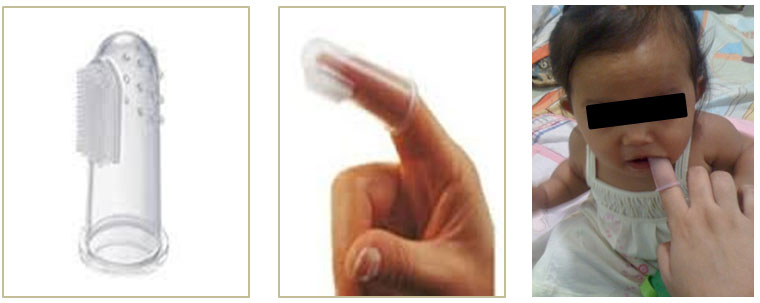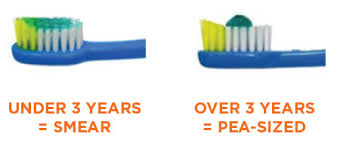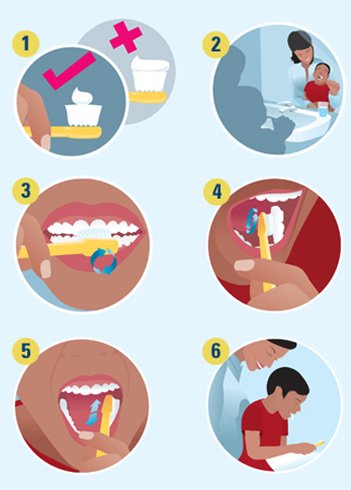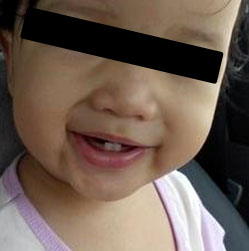Do parents need to clean their baby’s gum before his teeth come in?
Yes. Even before the first baby’s tooth emerging, it’s a good idea to get the habit of wiping his gums with gauze or a soft washcloth after every feed or during bath time. There is no need to use any toothpaste yet. Simply wrap the cloth or gauze around the finger and rub it gently over his gums to clear harmful bacteria from baby’s mouth.
When can I expect my child’s first tooth to come in?
Generally, baby’s first tooth will most likely to be a bottom front one, appearing at about six months of age. However, the time a baby’s tooth appears can vary hugely. Some babies still have no teeth by the age of one.
When should parents start brushing their baby’s teeth?
Parents are advised to start brushing their baby’s teeth as soon as the first little tooth bud emerging in the mouth. Early start from birth will instil good oral health habits to the child.
|
|
Figure 1: Baby’s first tooth, appearing at about six months of age. |
How often should parents brush their baby’s teeth?
Twice daily especially in the morning and night before bedtime.
Do parents need to buy a toothbrush for their baby?
It depends. Parents may find it easier to clean their baby’s teeth using a piece of clean gauze or wet towel. Wrap it around the finger, put a tiny smear or rice-sized of toothpaste on it, and rub it around baby’s teeth and gum.
If parents would rather use a baby toothbrush, pick one with a small head, soft nylon bristles and grip suitable for one’s finger. Use a tiny smear of toothpaste and brush gently on the inside and outside of each teeth to remove plaque and debris.
Specially designed toothbrushes such as finger toothbrush may also help parents brush their baby’s teeth.

Figure 2: Finger toothbrush
How often should you replace your baby’s toothbrush?
It should be replaced regularly, about every one month to three months. If the bristles start to spread out, it’s a sign that the toothbrush needs changing.
What kind of toothpaste is best for babies?
Parents are advised to look for a toothpaste made for babies. Check the packaging for fluoride levels to make sure the right toothpaste. Under-threes (1 to 3-year-old child) should use a lower-fluoride toothpaste, containing about 1,000ppm (parts per million) of fluoride.
Choose a toothpaste that doesn’t have a tasty, fruity flavour, so the baby learns that toothpastes aren’t food. Swallowing large amounts of fluoride could damage teeth, giving them a mottled effect, and may even make the baby sick or give him diarrhoea.
How much toothpaste should be used?
It depends. For babies aged under 1 year old, there is no need to use any toothpaste yet.
For children aged 1 to 3 years, only a smear or thin film of toothpaste covering less than three-quarters of the brush will be fine.
For children aged 3 years and above, brush child’s teeth with a pea-sized amount of toothpaste.
Parents are advised to educate their child to spit after tooth brushing and should not allow to eat or lick toothpaste from the tube.

Figure 3: Comparison of a smear with a pea-sized
amount of toothpaste.
How should parents brush their child’s teeth?
Parents are advised to start to brush their child’s teeth with an infant toothbrush or a fingertip toothbrush. A small amount of toothpaste and water is all that is needed.
 |
Figure 4: Step by step brushing technique (child aged 1 year and above)
|
References
- Oral Health Division, Ministry of Health Malaysia. Guidelines Early Childhood Oral Healthcare 2008. MOH/K/GIG/3.2008.
- American Academy of Pediatric Dentistry. Guideline on Infant Oral Health Care. Reference Manual. 2014;V37; No.6;15/16.
| Last Reviewed | : | 23 August 2019 |
| Writer | : | Dr. Azura bt. Abdullah |
| Accreditor | : | Dr. Salleh bin Zakaria |
| Reviewer | : | Dr. Sharol Lail bin Sujak |








